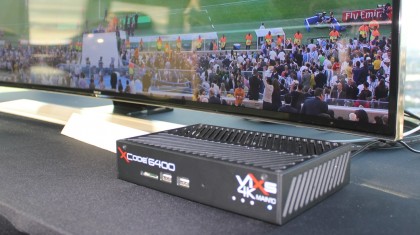4K TV broadcasts are on the way but there are problems ahead

As the final whistle was blown in Rio, the BBC's engineering team collectively breathed a sigh of relief.
Its ambitious trial to deliver 4K live, simultaneously via DTT over the air and the Internet, appeared to have been a resounding success.
I was invited along to watch the epochal kickabout at BT Tower, which offered an unprecedented opportunity to compare both feeds on nearly every major brand 4K UHD TV available.
The event, organised by the Corporation, BT and Arqiva, was hailed as "a unique moment" in broadcasting history. But it also highlighted some unusual problems and anomalies.

Problems ahead for 4K
"While all screens were fed uniform content, clearly not all UHD image processing is created equal"
The BT Tower was equipped with Ultra HD TVs from Samsung, Sony, LG and Panasonic, along with very early prototype set top boxes from Humax, Sagemcom and VIXS.
Unsurprisingly there were differences between them, although not quite what you might expect.
Sign up for breaking news, reviews, opinion, top tech deals, and more.
While all screens were fed uniform content, clearly not all Ultra HD image processing is created equal. A Panasonic screen with prototype firmware was running a full five seconds behind nearby rival screens from LG, Sony and Samsung.
For live sports that's obviously a deal breaker, so the poor panel was left largely unwatched for the duration of the match. However that was nothing compared to a VIXS STB, which was a full minute behind its competition.
But it's not so easy to lay the blame purely at onboard HEVC decoding. According to VIXS director of sales Steven Pyne, both the Panasonic and the Samsung screens employ the same VIXS-made HEVC silicon. Yet the two were clearly out of sync.
The big experiment was both ambitious and all a bit last minute, reveals Pyne.
While plans have been in place for 4K trial coverage of the Commonwealth Games for some time, the opportunity to play in the FIFA sandbox came relatively late in the day.
"We were given very little time to build our set top box sample," says Pyne. Still the opportunity appears to have been relished by everyone. "We've learnt an awful lot, from getting signals back to squashing signals down," says BBC Technology centre Head Andy Wilson.
The matches themselves were acquired by Sony broadcast cameras in h.264 and then encoded in HEVC in the UK for delivery utilising the MPEG-DASH standard.

25mbps needed for 4K?
"The adaptive bitrate system used had little tolerance, defaulting to regular HD whenever it dipped below 36Mbps"
Significantly, IP delivery required 36Mbps. When pushed on what might be a commercially viable 4K stream, one BBC engineer offered: "Possibly 25Mbps?"
This in itself shows just what a remarkable job Netflix is currently doing with its 4K streaming service, which requires a mere 15.6Mbps. Of course there's a big difference delivering 4K VoD compared to a live stream at 2160/60p. "It's far more challenging delivering Ultra-HD live, " I was told, "as you're compressing the streams on the fly and don't have the luxury of time to compress further and further. Also, the type of content makes a huge difference to the required bitrate, as sport is typically shot at higher frame rates than a drama, for example, and is generally much harder to encode as it often includes fast-moving or complex motion.
While the live transmissions, including the final ("There was no safety net, if the system had failed we would have been plenty of unhappy people here!") played out without any obvious problem, there were no shortage of backstage drama, not least maintaining definition.
On the night I was told by a BBC engineer that that the adaptive bitrate system used actually had very little tolerance, defaulting to regular HD whenever it dipped below 36Mbps. This has subsequently been denied by the BBC's R&D department.
IP delivery into BT Tower itself was via standard BT Home Hub 5s and the BT Infinity fibre optic network ("We wanted to replicate a real world experience as much as we can," I was told).
Technicalities aside, as a viewing experience the event was flat-out amazing.
Soccer in 2160p at 60Hz is spectacular. I'm no great fan of high frame rate TV as a rule, but it's clearly ideal for sport. There's a buttery smoothness to the play which looks utterly believable.
Couple this to 4K's astonishing resolution, and the temptation to stand as close as possible to the screen simply to soak up the fidelity is too difficult to resist.
The most impactful shots actually involved the crowds; a sea of faces, each cleanly delineated, seemed to add scale to the broadcast, while the big crowd close-ups oozed emotion. The images were extraordinarily compelling.
But not everyone was so impressed. One of the BBC engineering team confided to me.
"This is nothing really, we're currently researching 4K at 100/120fps. Now that really looks unbelievable, it's like a window."
With 4K, it seems there's everything still to play for.

Steve has been writing about AV and home cinema since the dawn of time, or more accurately, since the glory days of VHS and Betamax. He has strong opinions on the latest TV technology, Hi-Fi and Blu-ray/media players, and likes nothing better than to crank up his ludicrously powerful home theatre system to binge-watch TV shows.